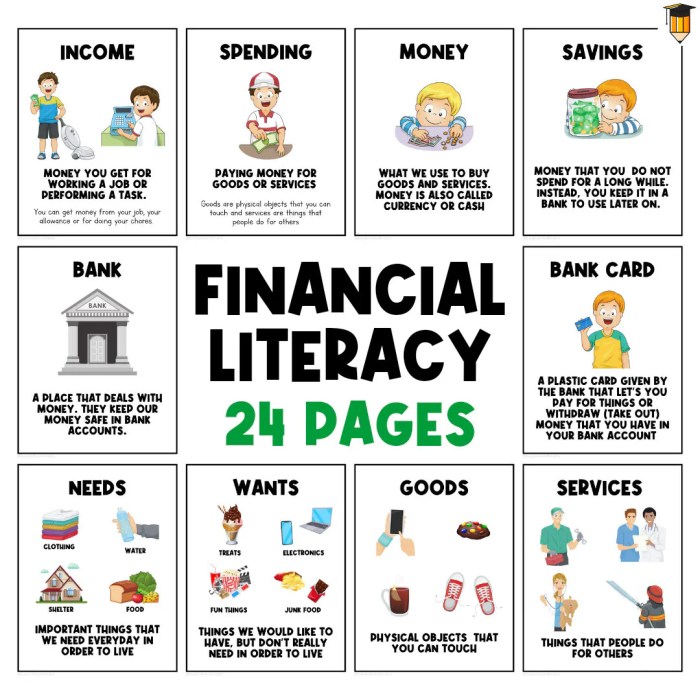Diving into the world of Financial literacy for kids, get ready to explore the ins and outs of money management in a way that speaks to the younger generation.
In this guide, we’ll break down the importance of teaching financial literacy early on and how it can shape a child’s future.
Importance of Financial Literacy for Kids
Teaching financial literacy to kids at a young age is crucial for setting them up for a successful future. By instilling these skills early on, children can develop a strong foundation in managing money, budgeting, and making smart financial decisions.
Building Financial Awareness
Financial literacy education helps children become more aware of the value of money and the importance of saving. Learning how to differentiate between needs and wants can prevent impulse spending and promote responsible financial habits.
Creating Long-Term Financial Stability
Equipping kids with financial literacy skills early can lead to long-term financial stability. By understanding concepts like budgeting, saving, and investing, children can build a strong financial future and avoid falling into debt traps.
Empowering Economic Independence
Early financial education empowers children to make informed financial decisions as they grow older. Teaching them about the basics of earning, saving, and investing can give them the confidence to manage their finances independently and achieve financial goals.
Setting the Stage for Success
Introducing financial literacy at a young age can set children up for success in adulthood. By teaching them how to manage money wisely, children can develop good financial habits that will benefit them throughout their lives.
Basic Concepts to Teach Kids
Teaching kids about financial literacy is crucial for their future success. By introducing basic concepts early on, children can develop good money habits that will benefit them for life.
Saving Money
- Explain to kids the importance of saving money for future needs or emergencies.
- Encourage them to set savings goals, such as saving for a toy or a special treat.
- Teach them the concept of delayed gratification – waiting to buy something they want instead of impulse buying.
Budgeting
- Show kids how to create a simple budget by dividing their allowance or earnings into categories like saving, spending, and giving.
- Help them track their expenses and income to understand where their money is going.
- Teach them the importance of prioritizing needs over wants when budgeting.
Investing
- Introduce kids to the concept of investing by explaining how putting money in a savings account or buying stocks can help grow their money over time.
- Teach them about the power of compound interest and how it can make their savings grow faster.
- Encourage them to invest in things they believe in, such as companies that make products they love or support causes they care about.
Creative Ways to Teach Financial Literacy
Financial literacy can be a challenging topic for kids to grasp, but with the right approach, it can be made fun and engaging. By incorporating games, activities, and tools, children can learn valuable money management skills in an interactive way. Parents, schools, and communities all play a crucial role in promoting financial literacy among kids and setting them up for a successful financial future.
Interactive Games and Activities
- Board Games: Games like Monopoly or The Game of Life can teach kids about financial concepts such as budgeting, investing, and managing money.
- Online Simulations: Websites like Practical Money Skills offer free interactive games that simulate real-life financial scenarios for kids to navigate.
- Piggy Banks: Encouraging kids to save money in a piggy bank can help them understand the importance of saving and setting financial goals.
Role of Parents, Schools, and Communities
- Parents: Parents can lead by example by demonstrating good financial habits and involving kids in family budgeting discussions.
- Schools: Integrate financial literacy into the curriculum through interactive lessons and workshops to help kids develop money management skills from a young age.
- Communities: Organize financial literacy events or workshops for kids to learn about topics like budgeting, saving, and investing in a fun and engaging way.
Setting Financial Goals with Kids

Setting financial goals with kids is crucial for their long-term financial well-being. By teaching children the importance of setting goals and working towards them, parents can instill valuable money management skills early on. Here are some tips on how to assist kids in setting realistic and achievable financial goals:
Tips for Setting Realistic Goals
- Start small: Encourage kids to set achievable goals that can be reached in a short period of time. This will help build their confidence and motivation.
- Make it specific: Help kids define their goals clearly, whether it’s saving for a new toy or setting aside money for a special outing.
- Set a timeline: Teach kids the importance of setting a deadline for their goals to create a sense of urgency and accountability.
- Celebrate milestones: Acknowledge and celebrate each step towards their goal to keep them motivated and engaged.
Benefits of Involving Kids in Planning and Saving
- Teaches responsibility: Involving kids in setting financial goals helps them understand the value of money and the importance of saving for the future.
- Builds good habits: By starting early, children can develop healthy financial habits that will benefit them throughout their lives.
- Promotes independence: Planning and saving for their own goals empowers children to make smart financial decisions on their own.
- Encourages goal-setting: Setting financial goals at a young age fosters goal-setting skills that can be applied to various aspects of their lives.
